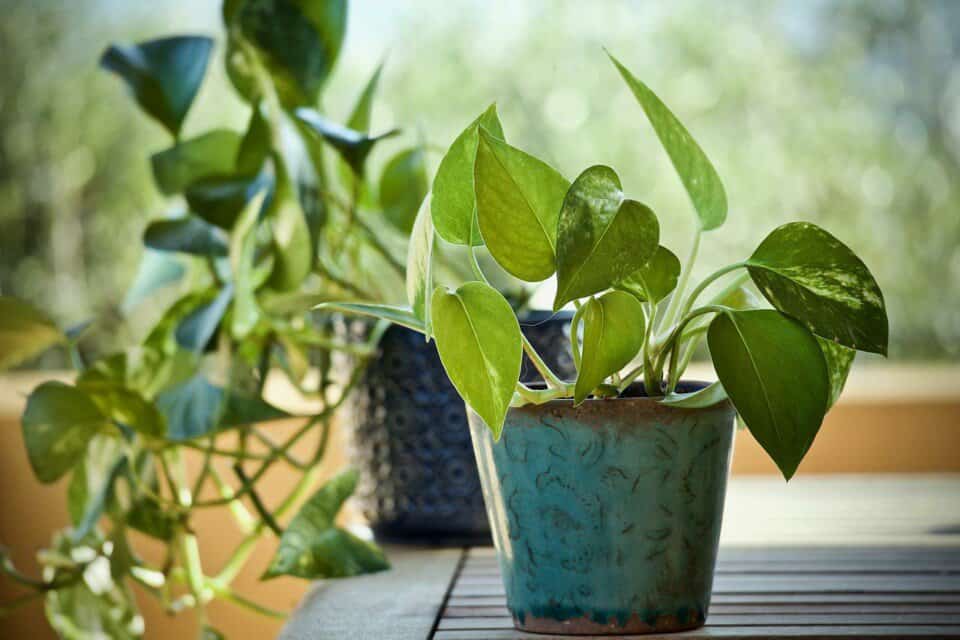Some links in the post are affiliate links and I get a commission from purchases made through some links found in the post.
A pothos plant is one of the most loved houseplants, the foliage of it is just simply beautiful and it can be modified and rearranged in many different ways.
Not only it is perfect decor but also is pretty low maintenance. Therefore, you can have one without fear even if you are not experienced in plant care.
Pothos plants thrive in many different environments and as already mentioned, you can modify them according to your taste and wishes.
One of the ways includes growing them with a moss pole. Having a Pothos grow on the moss pole is easy and will only require help in the first few weeks. After the plant sprouts new aerial roots, it will start to grow upwards on its own.
Some pothos plant lovers may not know that with the use of moss poles, pothos plants will be lushed, larger, healthier, and aesthetically beautiful.
Therefore, in this article, we will discuss in detail how to grow a pothos with a moss pole and what to consider.
Does my Pothos Need a Moss Pole?
 Moss poles are one of the finest methods plant owners may use to create beautiful decorations with their pothos plants.
Moss poles are one of the finest methods plant owners may use to create beautiful decorations with their pothos plants.
By use of the Moss pole, you can urge plants to grow in an upward direction instead of growing down. Since the Pothos plant has a climbing nature, it can be perfect to attach it to a moss pole.
Pothos plant is native to tropical environments, and in its natural habitat, it is typically found climbing on the trees.
Therefore, a moss pole can serve a similar purpose and be used as a “false tree”. It can give your houseplant support to climb upwards and can create pretty good decoration.
Although the genus Pothos doesn’t require a moss pole, it can benefit from one by having access to more support, water, and bigger leaves.
Pothos plants will grow downwards without moss poles and have significantly smaller leaves.
However, people also get the hanging pots or small baskets for the pothos plants and let them grow downwards.
It is a matter of taste. However, The Pothos with a moss pole will give you the possibility to shape your pothos plant as you wish.
Some of the best species of pothos plants to be used with a moss pole are:
- Marble Queen Pothos
- Silver Pothos
- Neon Pothos
- Golden Pothos
- Jessenia Pothos
- Manjula Pothos
Will a Pothos Climb a Moss Pole?
In addition to enjoying the beauty of moss poles, pothos plants will benefit from its assistance by developing larger, healthier leaves.
However, you may wonder what caused the leaves to be larger on the pothos? well, The moss pole acts as a nutrient-rich medium, similar to coir or soil.
As it ascents the moss pole, the pothos can plant roots in it, which strengthens its base.
The vast majority of types of pothos plants can be trained to go up to a moss pole. Although it is much easier and simpler if you start with smaller plants. Take your moss pole and sprinkle it with some water or soak it.
You may place the moss pole in the rear or in the center of the plant, according to how you want the finished result to look.
The longest vines of the pothos plant should be wrapped around the pole and secured and tight as you go.
This may be accomplished in a number of ways, such as by utilizing velcro strips, garden twine, or flower pins. Repeat this procedure for each pothos vine.
How to Pick a Moss Pole
The term “moss pole” goes by many different names including plant supports, climbing poles, moss totems, etc. It’s a vertically-positioned stick covered with moss or natural coco coir fiber.
A moss pole’s function is to mimic the natural habitat in which a climbing vine would develop and to supply it with water and micronutrients via aerial roots.
The moss pole essentially serves as a false tree to where your pothos can climb and is a great alternative for a broad range of beloved houseplants. The moss pole supports and feeds your plants while also adding a stunning look.
At first, moss poles were used as a specialty item, however, today, more and more plant owners choose them. Moss poles are now more widely common and accessible.
Even though your neighborhood garden shop might not have a conventional moss pole. The simplest way to buy a straightforward choice is online.
The cost of these moss poles, which varies based on size and number, is rather low, falling between $10 to $30.
The “best moss pole” is ultimately a matter of personal choice and preferences when making a purchase. A climbing pole will often have inner support, which frequently withers a PVC pipe or wooden slab.
Typically, this inner support is circled around with bamboo. The outer part is wrapped with sphagnum peat moss or coir fiber. Purchasing a pothos moss pole is often a better choice, however, you can also make one on your own.
How do I Attach a Pothos to a Moss Pole?
 A moss stick is really easy to use. The first several steps are most essential, because, they determine how successfully your pothos will climb on a moss pole. You actually just need a few items to grow your pothos on a pre-purchased moss pole:
A moss stick is really easy to use. The first several steps are most essential, because, they determine how successfully your pothos will climb on a moss pole. You actually just need a few items to grow your pothos on a pre-purchased moss pole:
- Pothos Plant
- Moss pole.
- Any kind of supporters (Green ties, twisted ties, string, etc.)
As for the first step, You can simply put the stick in the pit’s soil. However, make sure not to damage the roots.
You will have to put the stick as far from the stem as possible so it will not cause any harm to the pothos plant. The moss pole has to be firmly adjusted and fixed into one place.
At this stage, the moss pole has to be solid. After positioning it, you may use virtually anything to secure your plant to the pole.
You can use pretty much anything that will do the job to attach the pothos plant stem on the pole firmly.
For this purpose, you can use green ties, twisted ties, anglers’ lines, and strings. Here, you are free and you can attach the plant in any way you wish.
Repotting a Pothos with a Moss Pole
Training the younger pothos plant is much easier than the older one. However, nothing is impossible.
If you have already developed a pothos plant and want to let it grow on the moss pole, it is absolutely possible if you follow the guidelines carefully.
First of all, take the pothos out from an old pot and gently clean off the leftover soil. Take the pot that is large enough to have space for the plant and for the moss pole.
Additionally, make sure to put the well-draining potting soil that also retains moisture well. Pothos plants will also do fine in a soilless mix.
Additionally, by adding the perlite or coco coir, you can increase the drainage of the dirt. Always repot your pothos at the beginning of the growing season.
place the moss pole in the center of the pot, and cover it with a bit of soil. After you fix the pole to one place, put the pothos plant in the pot and add some more soil, so both the plant and the moss pole stay still.
After that, you can start pinning the pothos plant vines on the pole. you can either wrap it around or point upwards straightaway.
This is totally up to your wishes and imagination. Put the pins closer to each other, because the plant is already established and will require some additional support to stay attached.
With each vine, repeat this action until only the shortest ones are left. The vines that are too short to be wrapped around the pole can be left dangling out of the pot or left at the foot of the pole.
Gradually, they will start to climb too. Once your pothos is fastened to its pole, take care of your plant as usual but add frequent watering.
The plant will grow stronger, bigger, and lusher since this will imitate the rain that would stimulate the roots to bury themselves in the moss.
After several weeks, you will see aerial roots shooting out from the vines and the pothos will actually start to get themselves attached to the pole without any additional help.
How to Train a Pothos with a Moss Pole
Training pothos plant with a moss pole is not a difficult process at all. It requires some help and attention in the first few weeks, however, soon after, pothos will start to keep climbing on their own.
Make sure to put more support in every 3-5 inches. The aerial roots will often start attaching to your moss pole in a few weeks, so this is typically a transitory situation.
This is a kind of training phase for the plant. Your plant will need to be tied to the moss pole as slowly makes the aerial roots.
Eventually, once the plant gets aerial roots developed, your pothos will figure out how to grow up the moss pole without your help.
The ability of the moss and coco coir (produced from coconut fiber) is to retain moisture. This is one of the main advantages of the moss stick.
Your plants will benefit in several ways from this. First, the water retention of the pothos moss pole will allow plants to receive water when required through its aerial roots.
One of the most important things about this situation is that the pole is also a source of humidity, which is extremely beneficial to these tropical plants.
You can water the top part of the moss pole twice a week in summer, and this will provide enough moisture for the plant to thrive.
What Alternatives are There for a Moss Pole?
 One of the alternatives for pothos moss poles is the use of a trellis. However, the pothos plants in most cases feel better on moth poles.
One of the alternatives for pothos moss poles is the use of a trellis. However, the pothos plants in most cases feel better on moth poles.
This is because their aerial roots can cling to moss poles in a similar fashion to how they would do to a mossy tree in the wild.
Therefore, this creates a kind of a natural environment for them. A spreading plant is kept focused on upward development by moss poles. Trellis may also be pretty attractive, and encourages the plant to grow in any desired shape.
A wonderful pothos moss pole substitute, if you don’t want to spend a lot of money, is bamboo canes (or stakes). They can be easily trimmed to the right size and are generally accessible.
If you know where to search, you might be able to get some at a gardening supply store at no cost. They do not, however, offer the same nutritional advantages as a moss pole does.
In essence, a coir pole is kind of similar to a pothos moss pole. This one is made from coco coir fiber. Its resistance to decay and mold, therefore, is considered to be a wise substitute for pothos moss poles.
However, the disadvantage of the coir pole is that the coir can release salts into the soil and therefore, you will need to alter your fertilization schedule.
You may purchase coco coir poles or create your own by utilizing coir and setting up has the same instructions as for moss poles.
If you’re looking for something entirely weather-resistant, PVC pipe is a good alternative to moss poles. However, it has some disadvantages in comparison to the moss poles.
It can cause the soil to absorb chemicals and has no aesthetical appearance.
Similar to PVC pipes, the metal pipe is also the weather-resistant choice of moss pole alternative for your pothos.
It is kind of similar in function to PVC pipe but comes with a more superior aesthetical side and there are no threats of chemicals leaching into the soil.
The biggest drawbacks, though, are that it’s heavy, tough to cut, and unattractive to plants. For this reason, metal pipes are recommended to only be used as a last option or if they truly complement your architectural preferences.
Alongside the bamboo canes, wood stakes are one of the most common choices. Any type of wood product, including unused or recycled timber, new wood, or tree branches, can be used.
Before setting up, Make sure the wood has not been painted or chemically treated if it is reclaimed.
Final Thoughts
You can “form” your plant a little bit better when you use a moss pole. A pothos moss pole is a terrific alternative if you want to mold your plant to fit your living area and give it the appearance you want.
All you need after getting a pothos plant is to buy a moss pole and attach your plant to it in some ways.
The use of a moss pole may look intimidating at first, but after trying it, you will find that it is extremely beautiful and simple to use.
Your pothos plant will only require a little assistance, and once you give it away, then it will rapidly grow around a moss pole on its own.


